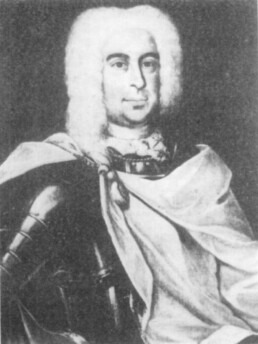Karol Erdmann Henckel
He was the second and youngest son of a Count Charles Maximilian and his second wife, Helena Jadwiga, Countess von Roedern. At first he lived in the shadow of his brother Leon Maximilian who, as an elder, took over the family property in 1716.
Translated from Source: Karol Erdmann Henckel
Picture of Karol Henckel
He was the second and youngest son of a Count Charles Maximilian and his second wife, Helena Jadwiga, Countess von Roedern. At first he lived in the shadow of his brother Leon Maximilian who, as an elder, took over the family property in 1716.
Eleven years later – on August 5, 1727 – the brothers made an agreement. Leon Maksymilian for the sum of 20 thousand. gulden, he gave all inherited property to Karol Erdmann – i.e. Tarnowskie Góry’s fideikomis Świerklaniecki – together with the power over Tarnowskie Góry and surrounding lands. It was not a small amount, considering that the annual proceeds to the Tarnowskie Góry municipal treasury were only PLN 4,000–6,000. golden.
Karol Erdmann was a tolerant man. The situation forced him to some degree. Alone Protestant he was subject to the Catholic ruler – Habsburg – Emperor and the King of Bohemia . In 1732 he agreed to settle a Jewish family in Tarnowskie Góry. However, she had to pay 1000 guilders for it. The count himself reported this fact to the superior office in Wroclaw .
The visit in 1734 was an event in the life of the count and the city elector Saxony Frederik Augustus II Wettin who was on his way to Krakow for his royal coronation. He later ruled the Republic of Poland under the name Augustus III of Saxony .
The major change was the fact of the transition Silesia and Tarnowskie Góry under the king of Prussia Frederick II the Great . On 20 November 1742, Count Charles Erdmann sent a letter to Hohenzollern requesting permission to conduct evangelical services, build a house of prayer and support a priest (with an income of 200 florins). Frederik’s quick response was on 8 December – the king agreed to Henckel’s wishes. Knowing the realities of these journeys, it can be assumed that the count was welcomed at the royal court.
On Henckel’s initiative, a preacher was brought to Tarnowskie Góry, Samuel Ludwik Sasadius . It was he who, on 25 December 1742, inaugurated the parish hall on the market square in Tarnowskie Góry.
During the reign of Charles Erdmann, the inhabitants of Tarnowskie Góry and tragedies. In 1732 and 1737, during the epidemics of plague and typhus, more than 600 inhabitants of the city died. Tarnowskie Góry was also plagued by fires in 1734, 1742 and 1746. The town of miners also had reason to be proud. It is here that the authorities of the district, created in 1742, found their seat Bytom . In 1754, in the building at ul. 4 Gliwicka Street, a Protestant school was opened, which became one of the most significant in those days.
Karol Erdmann ruled the city and the surrounding area for over thirty years.
